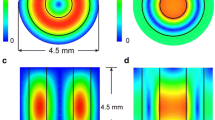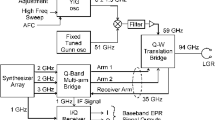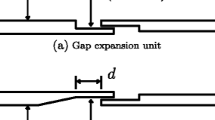Abstract
At high frequencies, e.g., Q- and W-bands, it is advantageous to make the axial length of loop-gap resonators (LGRs) at least as long as a free-space wavelength. The opposite scaling of capacitance and inductance with LGR length suggests that the length of an LGR can be increased without limit, with the axial radio frequency (rf) field profiles and resonance frequency independent of length. This scaling is accurate for resonator dimensions much less than one free-space wavelength. When the resonator length approaches one-tenth of a free-space wavelength, the rf field uniformity degrades. From one-tenth to one free-space wavelength, computer simulations and experimental measurements show that the axial magnetic field energy density profile is peaked in the center of the LGR, gradually decreases from 25 to 50% at a distance one radius from the end, and rapidly there-after. The nonuniformity is of two types. One type, in the vicinity of one radius of the end, is caused by the flaring of the field as it curves from the central loop to the end region, into the larger return loop(s). The other type, in the central part of the resonator, is caused by impedance mismatch at the ends of the LGR. The LGR may be viewed as a strongly reentrant (ridge) waveguide nearly open at both ends and supporting a standing wave. A transmission line model relates the central nonuniformity to the fringing capacitance and inductance at the ends of the resonator. This nonuniformity can be eliminated in several ways including modifying the ends of the LGR by adding a small metal bridge or a dielectric ring. These uniformity trimming elements increase the fringing capacitance and/or decrease the fringing inductance. With trimmed ends, LGRs can be made many free-space wavelengths long. The maximum resonator length is determined by the proximity in frequency of the fundamental LGR mode to the next highest frequency mode as well as the quality factor. Results of this theory are compared and conformed with finite-element simulations. This theory connects the uniform LGR with the uniform field cavity resonators previously introduced by this laboratory.
Similar content being viewed by others
References
Froncisz W., Hyde J.S.: J. Magn. Reson.47, 515–521 (1982)
Hyde J.S., Froncisz W. in: Advanced EPR: Applications in Biology and Biochemistry (Hoff A.J., ed.), pp. 277–306. Amsterdam: Elsevier 1989.
Rinard G.A., Eaton G.R. in: Biomedical EPR. Part B: Methodology and Instrumentation. Biological Magnetic Resonance, vol. 24 (Eaton S.S., Eaton G.R., Berliner L.J., eds.), pp. 19–52. New York: Kluwer Academic/Plenum 2004.
Froncisz W., Oles T., Hyde J.S.: Rev. Sci. Instrum.57, 1095–1099 (1986)
Hyde J.S., Yin J.-J., Subczynski W.K., Camenisch T.G., Ratke J.J., Froncisz W.: J. Phys. Chem. B108, 9524–9529 (2004)
Robins W.P.: Phase Noise in Signal Sources, p. 53. London: Peter Peregrinus Ltd. 1982.
Hyde J.S., Sidabras J.W., Mett R.R. in: 46th Rocky Mountain Conference on Analytical Chemistry, Denver, CO, August 1–5, 2004, pp. 84–85.
Froncisz W., Hyde J.S.: J. Magn. Reson.47, 515–521 (1982)
Mett R.R., Froncisz W., Hyde J.S.: Rev. Sci. Instrum.72, 4188–4200 (2001)
Anderson J.R., Mett R.R., Hyde J.S.: Rev. Sci. Instrum.73, 3027–3037 (2002)
Hyde J.S., Mett R.R., Anderson J.R.: Rev. Sci. Instrum.73, 4003–4009 (2002)
Jackson J.D.: Classical Electrodynamics, 2nd edn. New York: Wiley 1975.
Smythe W.R.: Static and Dynamic Electricity, 2nd edn., chapt. IV. New York: McGraw-Hill 1950.
Ramo S., Whinnery J.R., van Duzer T.: Fields and Waves in Communication Electronics, 2nd edn., sect. 1.18. New York: Wiley 1984.
Hyde J.S., Yin J.-J., Subczynski W.K., Camenisch T.G., Ratke J.J., Froncisz W.: J. Phys. Chem. B108, 9524–9529 (2004)
Mett R.R., Sidabras J.W., Hyde J.S. in: 48th Rocky Mountain Conference on Analytical Chemistry, Breckenridge, CO, July 23–27, 2006.
Pennington P.M., Hyde J.S. in: 48th Rocky Mountain Conference on Analytical Chemistry, Breckenridge, CO, July 23–27, 2006.
Mett R.R., Hyde J.S.: J. Magn. Reson.165, 137–152 (2003)
Author information
Authors and Affiliations
Corresponding author
Rights and permissions
About this article
Cite this article
Mett, R.R., Sidabras, J.W. & Hyde, J.S. Uniform radio frequency fields in loop-gap resonators for EPR spectroscopy. Appl. Magn. Reson. 31, 573–589 (2007). https://doi.org/10.1007/BF03166603
Received:
Revised:
Issue Date:
DOI: https://doi.org/10.1007/BF03166603




